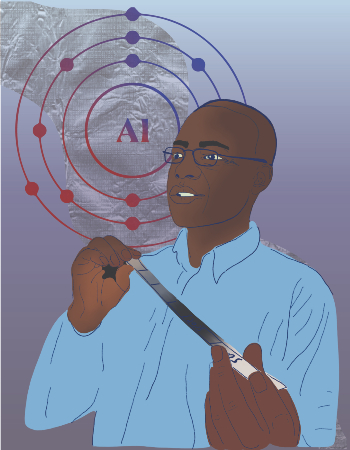
Eric Detsi, Stephenson Term Assistant Professor in Materials Science and Engineering, has received the National Science Foundation’s CAREER Award. The CAREER Award is given to early-career faculty researchers who demonstrate the potential to be role models for research and education and are committed to outreach and public engagement.
Detsi’s award will fund research on understanding and overcoming the fundamental barriers to sustainable production of aluminum, the most abundant metal in the Earth’s crust, and second-most-used metal worldwide after iron. As a lightweight and flexible metal, aluminum is ubiquitous, found in products ranging from soda cans to aircraft parts. The grant will also fund an outreach initiative bringing this research to underrepresented K-12 students at the Pennsylvania School for the Deaf through interactive science kits on the life cycle of aluminum.
Aluminum in its natural form occurs as aluminum hydroxide, abundant in Earth’s crust as bauxite ore. Converting that ore to aluminum, however, uses a 130-year-old, energy-intensive industrial process. High temperatures are used to first convert the aluminum hydroxide into aluminum oxide, also known as alumina, and then melt it to a point where pure aluminum can be extracted through electrolysis, which requires a significant amount of electricity. On top of the intensive energy used in the form of heat and electricity, making 1 kg of aluminum produces 14 kg of carbon dioxide as by-product, equivalent to the CO2 released from burning about 1.5 gallons of gasoline.
Detsi aims to create a sustainable aluminum production process by directly converting aluminum hydroxide to aluminum at room temperature.
“Instead of using high-temperature electrolysis of molten alumina, aluminum hydroxide can be directly reduced to aluminum metal at room temperature through a process involving hydroxide ions and an aqueous electrolyte. However, metallic aluminum is highly reactive to water, making the use of an aqueous solution problematic,” Detsi says.
“To overcome this challenge, we are working on developing a hybrid aqueous/non-aqueous electrochemical cell which can provide hydroxide ions while enabling aluminum to be made in a non-aqueous solution,” he says. “The ultimate goal of this project is to achieve a direct aluminum hydroxide-to-aluminum conversion at room temperature, a process that not only avoids any direct carbon emissions, but also eliminates any energy waste in converting aluminum hydroxide to alumina and melting the alumina.”
As with any innovative research, there are limitations to overcome. Detsi’s work will require improving the conversion yield and scaling up the technique so it can be used at an industrial scale. X-ray scattering techniques will help to characterize the morphology of reduced metallic aluminum and its impact on the conversion yield. X-ray characterization techniques coupled with advanced electrochemical techniques will allow Detsi and his colleagues to better understand these materials to produce aluminum more efficiently.
Creating more sustainable metal-production processes has been at the heart of Detsi’s scientific career.
“This CAREER project relates to my overall research interests on energy and sustainability in the sense that one cannot dissociate between ‘metal production’ and ‘environmental sustainability’ because of how large an impact these processes are having on the global environment,” says Detsi.
Detsi’s CAREER Award is intertwined with his previous research on the sustainable production of hydrogen. Given hydrogen’s prospects for replacing fossil fuels in vehicles, the ability to quickly generate it wherever it is needed would allay many of the safety concerns around storing and transporting the highly flammable gas.
“By bringing aluminum in a certain form in contact with water, hydrogen can be produced on-demand,” Detsi says. “This hydrolysis process to produce hydrogen from aluminum is an aluminum-to-aluminum hydroxide conversion, which is the reverse of the aluminum hydroxide-to-aluminum process that we are investigating for the CAREER project.”
The science behind these metal-production and clean-energy processes will be highlighted in the proposed outreach and education initiative.
“We plan on developing an educational kit on the life cycle of aluminum, starting from mining and purification of raw materials, aluminum smelting, the wide range of goods it is used in and, finally, the end of aluminum’s life cycle, when it degrades and returns to mineral,” says Detsi.
Given the societal importance of sustainability research, Detsi has been collaborating with education researchers to make sure his kits will reach the widest range of students.
“This kit will contain visual infographics, videos and animations, and it will be exhibited to The Pennsylvania School for the Deaf students either in-person at Penn or virtually,” says Detsi. “I learned from collaborators who have more experience in this area, that Deaf and hard-of-hearing students are visually inclined learners, meaning that using demos and educational kits to introduce them to our research is more effective.”
